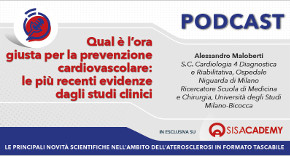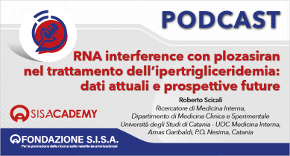 Rivista in lingua italiana
Rivista in lingua italiana
riservata ai Soci SISA
Ultimo numero:
Anno 16 • N.1/2025
SISANews
Statura e rischio cardiovascolare
Più si è bassi, più è alto il rischio cardiovascolare. Una statura più bassa di 6.5 cm è associata ad un maggior rischio relativo di cardiopatia ischemica dell'8% secondo una recente meta-analisi. La statura è controllata da vari fattori, tra questi, con un ruolo decisivo, quelli genetici di cui sono state identificate un gran numero di varianti indipendenti. Circa il 10% della variabilità dell'altezza è spiegata da 180 polimorfismi a singolo nucleotide e proprio con l'esame di questi polimorfismi in 193.449 soggetti, Nelson e collaboratori confermano i dati rilevati dall'osservazione epidemiologica, concludendo per l'esistenza di una significativa associazione tra bassa statura geneticamente determinata e rischio cardiovascolare. La spiegazione è incerta. La bassa statura si associa ad un peggiore profilo di rischio lipidico, ma questo non sembra sufficiente. Forse è da indagare se esiste una relazione tra i fattori biologici che determinano la bassa statura e quelli coinvolti nel rischio cardiovascolare.
![]()
Genetically determined height and coronary artery disease.
Nelson CP, Hamby SE, Saleheen D, Hopewell JC, Zeng L, Assimes TL, Kanoni S, Willenborg C, Burgess S, Amouyel P, Anand S, Blankenberg S, Boehm BO, Clarke RJ, Collins R, Dedoussis G, Farrall M, Franks PW, Groop L, Hall AS, Hamsten A, Hengstenberg C, Hovingh GK, Ingelsson E, Kathiresan S, Kee F, König IR, Kooner J, Lehtimäki T, März W, McPherson R, Metspalu A, Nieminen MS, O'Donnell CJ, Palmer CN, Peters A, Perola M, Reilly MP, Ripatti S, Roberts R, Salomaa V, Shah SH, Schreiber S, Siegbahn A, Thorsteinsdottir U, Veronesi G, Wareham N, Willer CJ, Zalloua PA, Erdmann J, Deloukas P, Watkins H, Schunkert H, Danesh J, Thompson JR, Samani NJ; CARDIoGRAM+C4D Consortium.
N Engl J Med. 2015;372:1608-18
BACKGROUND: The nature and underlying mechanisms of an inverse association between adult height and the risk of coronary artery disease (CAD) are unclear.
METHODS: We used a genetic approach to investigate the association between height and CAD, using 180 height-associated genetic variants. We tested the association between a change in genetically determined height of 1 SD (6.5 cm) with the risk of CAD in 65,066 cases and 128,383 controls. Using individual-level genotype data from 18,249 persons, we also examined the risk of CAD associated with the presence of various numbers of height-associated alleles. To identify putative mechanisms, we analyzed whether genetically determined height was associated with known cardiovascular risk factors and performed a pathway analysis of the height-associated genes.
RESULTS: We observed a relative increase of 13.5% (95% confidence interval [CI], 5.4 to 22.1; P<0.001) in the risk of CAD per 1-SD decrease in genetically determined height. There was a graded relationship between the presence of an increased number of height-raising variants and a reduced risk of CAD (odds ratio for height quartile 4 versus quartile 1, 0.74; 95% CI, 0.68 to 0.84; P<0.001). Of the 12 risk factors that we studied, we observed significant associations only with levels of low-density lipoprotein cholesterol and triglycerides (accounting for approximately 30% of the association). We identified several overlapping pathways involving genes associated with both development and atherosclerosis.
CONCLUSIONS: There is a primary association between a genetically determined shorter height and an increased risk of CAD, a link that is partly explained by the association between shorter height and an adverse lipid profile. Shared biologic processes that determine achieved height and the development of atherosclerosis may explain some of the association.
N Engl J Med. 2015;372:1608-18

Area Soci
Eventi
39° Congresso Nazionale
 39° Congresso Nazionale
39° Congresso NazionaleRoma, 23-25 novembre 2025
Save the date




 Spring Meeting Gruppi Giovani SID, SIGG, SIIA, SIMI, SIPREC, SISA
Spring Meeting Gruppi Giovani SID, SIGG, SIIA, SIMI, SIPREC, SISARimini, 6-8 aprile 2025
[continua a leggere]
 SISA LIPID ACADEMY - Corso avanzato di lipidologia clinica
SISA LIPID ACADEMY - Corso avanzato di lipidologia clinicaModena, 4-5 Luglio 2024
[continua a leggere]Giornale Italiano Arteriosclerosi
HoFH today
 Rivista Italiana della
Rivista Italiana della
Ipercolesterolemia
Familiare Omozigote
Anno 6 • N.1/2024
Rivista NMCD
Diateca
[continua a leggere]
[continua a leggere]
Newsletter
il vostro indirizzo di posta elettronica
Progetto LIPIGEN

Nuovo sito dedicato al Progetto LIPIGEN
Progetto LIPIGEN - Vecchio portale
E' necessario essere loggati come utente
Lipigen per poter accedere alla pagina
PROject Statin Intolerance SISA
PROSISA – PROject Statin Intolerance SISA
E' necessario essere loggati come utente
PROSISA per poter accedere alla pagina
GILA - Lipoprotein Aferesi
Gruppo Interdisciplinare Lipoprotein Aferesi
(Accesso Gruppo GILA-Lipoprotein Aferesi)
E' necessario essere loggati come utente del Gruppo GILA per poter accedere
Gruppo Interdisciplinare Lipoprotein Aferesi
(Documentazione ad accesso libero)
Pagina informativa per medici e pazienti










